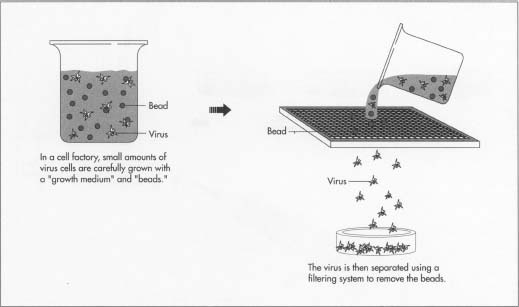Virus vaccines
For many centuries it was observed that individuals surviving the common and often fatal disease smallpox were subsequently protected from reinfection with the disease. Indeed smallpox was so feared that the practice of deliberate infection with a view to providing such protection became widespread. The procedure (named variolation from variola major, the smallpox virus) applied pus from a lesion (pock) of an individual infected with what appeared to be a nonlethal strain of the virus onto a scratch in the skin. Variolation was itself often fatal if the virulence of the original infection was misjudged, and was succeeded in the late 18th century following the early experiments of Edward Jenner (and others) with cowpox.
Jenner himself was the victim of near-fatal variolation as a boy; as a result he and his contemporaries pioneered a less dangerous procedure based on their observations that milkmaids who contracted the milder disease of cowpox, did not succumb to smallpox. Jenner introduced the cowpox virus (which gives mild, acute infections in humans) into some small boys whom he later challenged with virulent smallpox virus! Fortunately, Jenner’s theory was correct and the boys were protected against the disease. The success of this procedure (named vaccination from the Latin vacca (cow) as a tribute to Jenner’s work) was due to the fact that cowpox virus shares a number of antigens with smallpox virus but does not cause severe disease in humans. Cowpox replication had induced an immune response which, upon subsequent challenge with smallpox, was sufficient to prevent the closely related smallpox virus undergoing any significant infection. A hybrid cowpox virus of unknown origin, vaccinia virus (variola minor), was used by the World Health Organization (WHO) in a vaccination program that in 1977 succeeded in eradicating smallpox from the world. The WHO has an ambitious vaccination program that seeks to deliver vaccines to most children of the world and to eradicate many viruses in the near future. Since the launching of the polio vaccination program in 1998, the WHO has reported that the number of cases has fallen by 99% and the disease is now endemic in only four countries (WHO 2008).

The majority of vaccines in clinical use today are of two types, live (attenuated) or inactivated (killed) vaccines. More recent subunit vaccines contain selected virus proteins and many are being developed, along with several experimental DNA vaccines. Vaccines are administered by a number of routes – intramuscular, intradermal, subcutaneous, intranasal or oral.